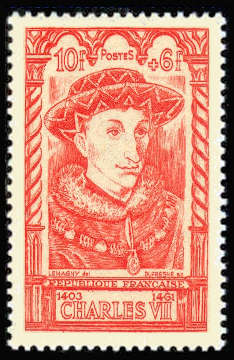TIMBRES DE FRANCE
Ex : 50 c
Ex : 456
Ex : Appel du 18 juin
Ex : 1900
Ex : Femme
mini 4 lettres
Création du site : Juillet 2005
Nombre de visiteurs : 34.188.395
Nombre de pages : 112.788.999
Dernière mise à jour 26-03-2025
Nombre de visiteurs : 34.188.395
Nombre de pages : 112.788.999
Dernière mise à jour 26-03-2025
Cette bannière est une publicité le site n'a aucune boutique de vente
Les informations sur ce timbre ont été mises à jour le : 19/10/2024

Charles VII (1403-1461) roi de France de 1422 à 1461
Timbre : Courant / moderne
Voir tous les timbres courants de l'année 1946
Listage des timbres de l'année 1946






Vente générale : 28 octobre 1946
Retrait de la vente : 14 mars 1947
Valeur faciale : 10 f + 6 f
Graveur : Charles Paul Dufresne
Dessinateur : Jean Fouquet
Département concerné par ce timbre : Paris
Dentelure : Dentelé 13
Couleur : rouge
Mode d'impression : Taille douce
Format du timbre : 26 x 40 mm (vignette 21,45 x 36 mm bords externes des filets)
Quantité émis : 2.200.000
Présentation : Feuille de 25 timbres
Bande phosphore : Sans
Catalogue Yvert et Tellier France : N° 770
Catalogue Spink / Maury France : N° 770
Catalogue Michel : N° FR 770
Catalogue Scott : N°B212
Valeur marchande timbre neuf avec gomme intacte: 0,68 €
Valeur marchande timbre neuf avec charnière : 0,39 €
Valeur marchande timbre oblitéré : 0,58 €
La valeur marchande représente une valeur de base du timbre pour la vente ou l'échange
Thématique catégorie : Batailles, tratés, rois, reine, personnages
Informations sur le sujet du timbre
Charles VII
est devenu roi en 1422 en pleine guerre civile entre Armagnacs et Bourguignons, compliquée d'une intervention militaire anglaise victorieuse depuis la bataille d'Azincourt (1415). Chef de fait du parti armagnac, il est déshérité par son père au traité de Troyes (1420) au profit du roi Henri V d'Angleterre puis du fils de ce dernier, Henri VI. Replié au sud de la Loire, le « roi de Bourges », comme on le surnomme par dérision, voit sa légitimité et sa situation militaire s'arranger nettement grâce à l'intervention de Jeanne d'Arc. Celle-ci délivre Orléans et conduit Charles VII à la cérémonie du...lire la suite
Charles VII
became king in 1422 during the civil war between the Armagnacs and the Burgundians, complicated by a victorious English military intervention since the Battle of Azincourt (1415). De facto leader of the Armagnac party, he was disinherited by his father at the Treaty of Troyes (1420) to the benefit of King Henry V of England and then of the latter’s son, Henry VI. Retreated to the south of the Loire, the «king of Bourges», as he is nicknamed by derision, sees his legitimacy and military situation clearly improved thanks to the intervention of Joan of Arc. This one delivers Orléans and leads Charles VII to the ceremony of the coronation in Reims.Charles VII takes faith in himself and steals from success in success, served by effective advisers and... another woman whose he makes the first official mistress of a king of France, Agnès Sorel, hence its nickname: the Bien Servi.
His advisors, often poorly rewarded by their sovereign, will return to France its place in the heart of Western Europe, engage its administrative modernization and drive out the English, Ending the Hundred Years' War for good.
Often criticized by posterity for having slowed down the reconquest of France begun by Joan of Arc and for having abandoned it to its fate after victory, Charles nevertheless had her formally rehabilitated in 1456 and cleared of any charge of heresy. He also worked to restore the economy thanks to Jacques Cœur, after having driven the English out of the kingdom.
Text created from several documents
Source : various Internet documents including Wikipedia
Cette page a été visitée 14 310 980 fois depuis le 1er mai 2022
